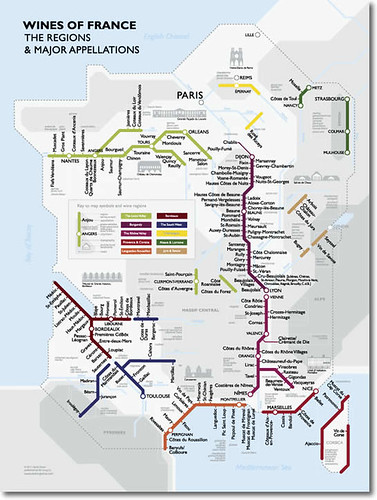 Do you know that it's only in 1931 that the first schematic subway map was designed by English engineering draftsman Harry Beck? Before that, we had route maps that were solely based on geography. They were lacking clarity and had many overcrowded areas. Schematic maps are based on topology and therefore show a simplified, hightly stylized network of stations that is much easier to understand.
Do you know that it's only in 1931 that the first schematic subway map was designed by English engineering draftsman Harry Beck? Before that, we had route maps that were solely based on geography. They were lacking clarity and had many overcrowded areas. Schematic maps are based on topology and therefore show a simplified, hightly stylized network of stations that is much easier to understand.So can we apply the same logic to wine regions and appellations to simplify and clarify regional and geographical concepts to beginners? Dr. David Gissen, professor at the California College of the Arts, thinks so and has recently published a Metro Wine Map of France.
Dr. David Gissen is a historian and theorist of architecture and urbanism but he is also a wine lover who, after drinking a bottle of 2009 Morgon Domaine Lapierre at Chez Panisse, wanted to learn more about wine and its relationship with particular philosophies and places.
In a recent interview, Gissen explains what motivated him to design his Metro map.
“I was just very frustrated with the fact that some basic ideas about the relationships between wine and geography that seemed so simple to me, after my own tastings, were not actually expressed simply anywhere. Part of the problem is the way the geographical description of French wine relies on a very literal languages of maps. What I mean by that is that if you look at almost any book on French wine, the maps look like the kind of thing that an explorer would use. They're extremely literal, cartographic views, so that all the regions are drawn with very precise jagged-line boundaries, and you're supposed to understand that this particular terroir stops just below this particular Autoroute in France, for example, and so on.”
“My feeling was that you could explain some very basic geographical ideas and principles about French wine if you used a visual language that was relational and condensed. To me, that means the language of the subway map.”
If you want to find the “best subway stop from which to embark on your own journey of wine exploration”, you can get the map here. And if you want to learn more about Gissen's interesting perspectives on concrete vinification, wine glass shapes, terroir, and the re-framing of wine using an urban aesthetics, read the full interview.
Technorati tags: wine food & drink
No comments:
Post a Comment